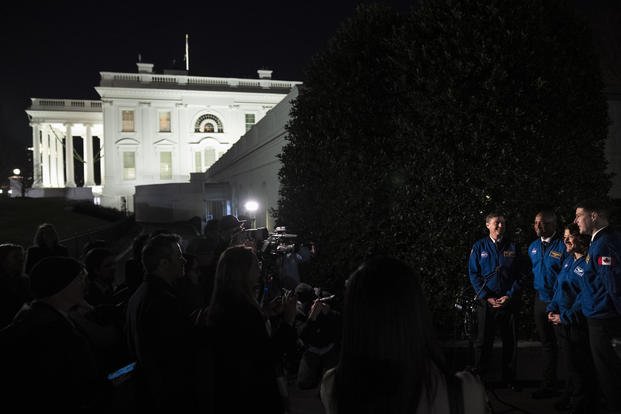WASHINGTON — The four astronauts assigned to fly around the moon for the first time in 50 years met with President Joe Biden on Thursday at the White House, where he showed off an moon rock on display in the Oval Office that was collected in the Apollo era.
The Artemis II crew — three Americans and one Canadian — said the president was making good on a promise to host them at the White House after they were named to the mission earlier this year. They also met with Vice President Kamala Harris.
“It's been really nice to shake their hands and tell them thank you for their leadership and making it possible for us to have this amazing journey," said pilot Victor Glover.
The four astronauts will be the first to fly NASA’s Orion capsule, launching atop a Space Launch System rocket from Kennedy Space Center no earlier than late 2024. They will not land or even go into lunar orbit, but rather fly around the moon and head straight back to Earth, a prelude to a lunar landing by two others planned for a year later.
“As the crew, we don't even think about the date,” said commander Reid Wiseman. “We will go when NASA and the vehicle are ready to fly.”
In the meantime, the crew is preparing. They use simulators and work with Mission Control on how to get up and back safely, including how to get out when they return to Earth. They have a dress rehearsal in February where they'll practice “bobbing around” in a capsule in the Pacific Ocean.
“It takes a huge team of people to put four humans ... to sling them around the moon and back and still have them breathing when they hit the Pacific. And we work with them every single day,” said mission specialist Jeremy Hansen, the Canadian member of the group.
This is the first moon crew to include someone from outside the U.S. — and the first crew in NASA’s new moon program named Artemis, after the twin sister of mythology’s Apollo. Late last year, an empty Orion capsule flew around the moon and back in a long-awaited dress rehearsal.
The astronauts got their first look at their spaceship in August. But investigations into the capsule’s heat shield could delay their trip. Last year’s test flight around the moon, with no one on board, resulted in unexpected charring and loss of material from the heat shield at the bottom of the capsule. The heat shield is meant to protect the capsule against the extreme heat of reentry.
Mission specialist Christina Koch said Biden talked about a speech John F. Kennedy gave in 1962 on the mission to the moon, and he referenced the part where Kennedy said the U.S. would go to the moon because the goal was a challenge and “one we are unwilling to postpone.”
“And that shows to me that he is committed to the mission that we have, that we are going to show through his leadership that we can do great things," she said.
During Apollo, NASA sent 24 astronauts to the moon from 1968 through 1972. Twelve of them landed. All were military-trained male test pilots except for Apollo 17’s Harrison Schmitt, a geologist who closed out that moon-landing era alongside the late Gene Cernan.
The moon rock on display in the Oval Office — Lunar Sample 76015,143 — is on loan from NASA. It was collected in 1972 by Schmitt and Cernan. The rock is believed to be about 3.9 billion years old, and it weighs a little less than a pound.











